
How to Use LoRaWAN: Examples, Pinouts, and Specs
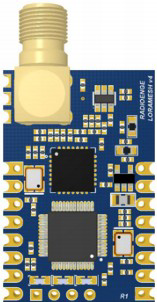
 Design with LoRaWAN in Cirkit Designer
Design with LoRaWAN in Cirkit DesignerIntroduction
LoRaWAN (Long Range Wide Area Network) is a low-power, wide-area networking protocol developed by Radioenge. It is specifically designed for wireless, battery-operated devices in regional, national, or global networks. LoRaWAN is optimized for low data rates and long-range communication, making it an ideal solution for Internet of Things (IoT) applications.
Explore Projects Built with LoRaWAN
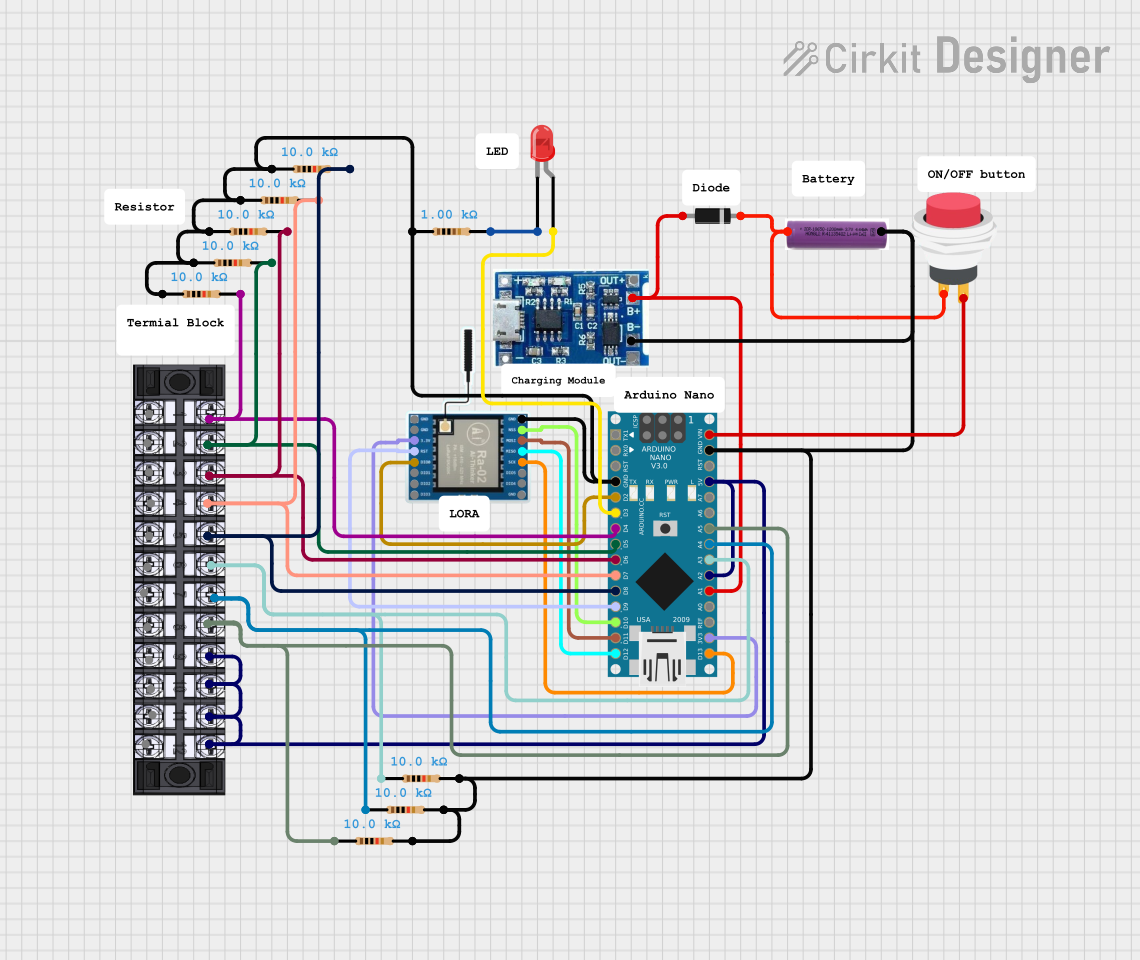
 Open Project in Cirkit Designer
Open Project in Cirkit Designer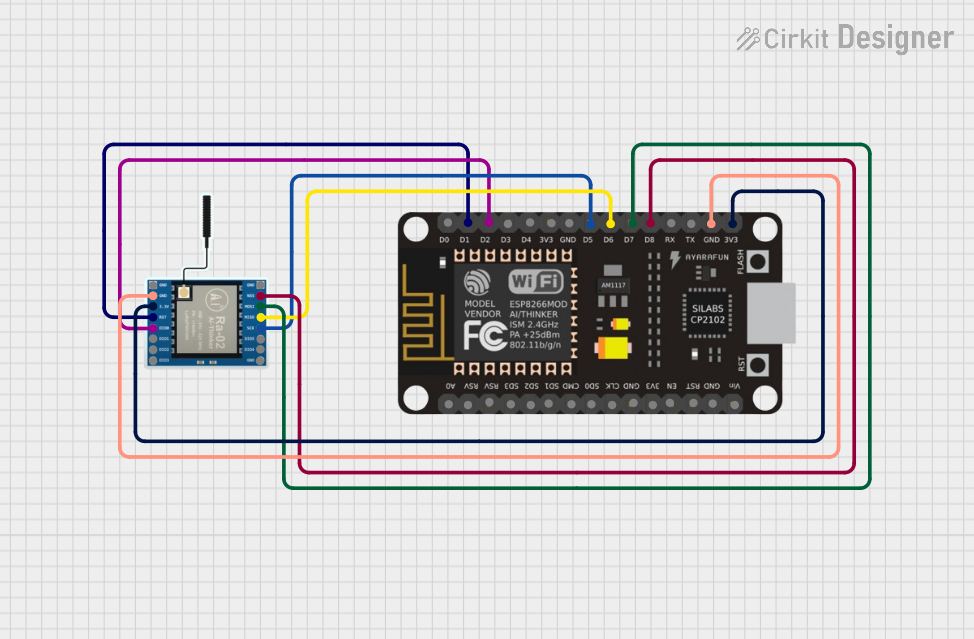
 Open Project in Cirkit Designer
Open Project in Cirkit Designer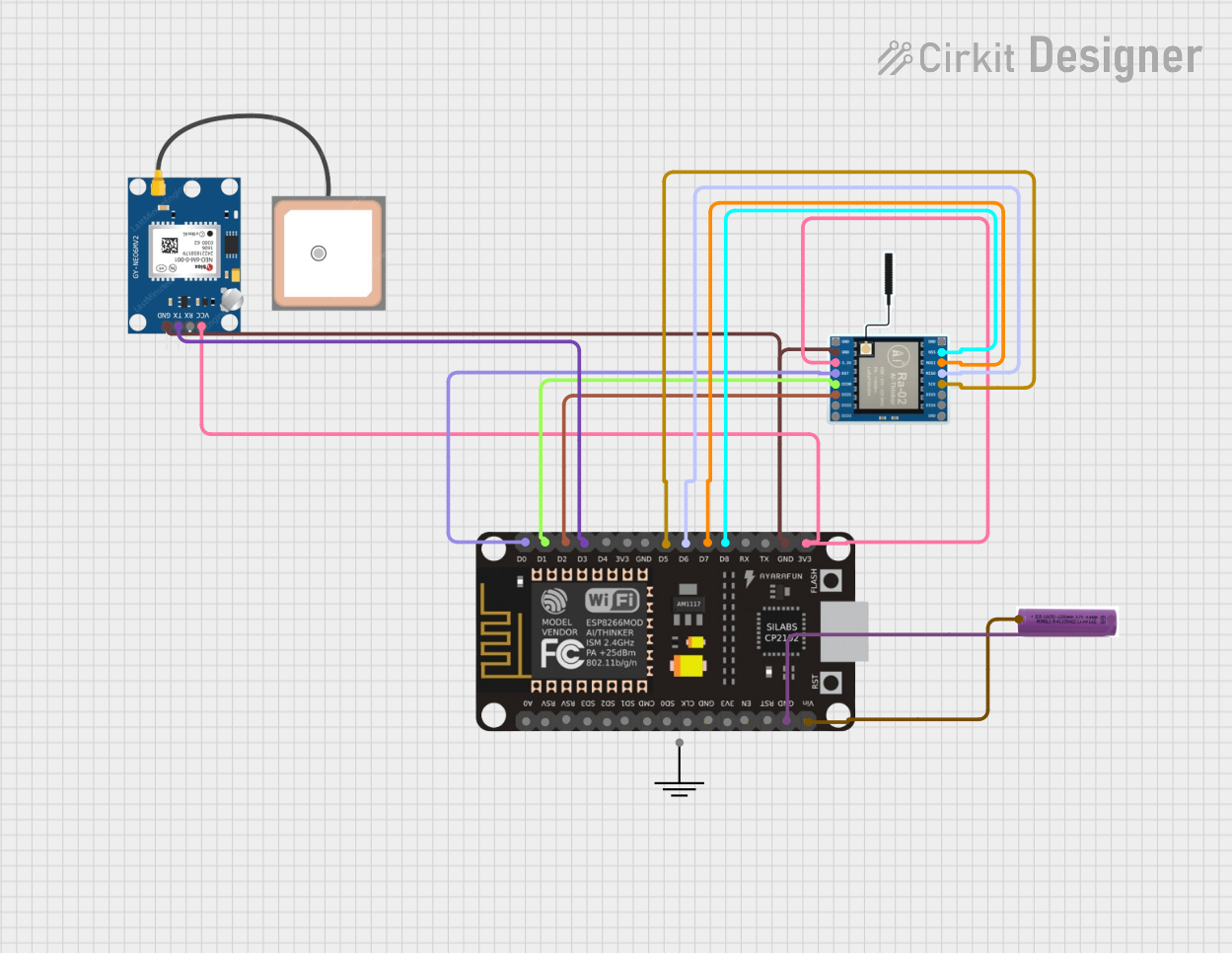
 Open Project in Cirkit Designer
Open Project in Cirkit Designer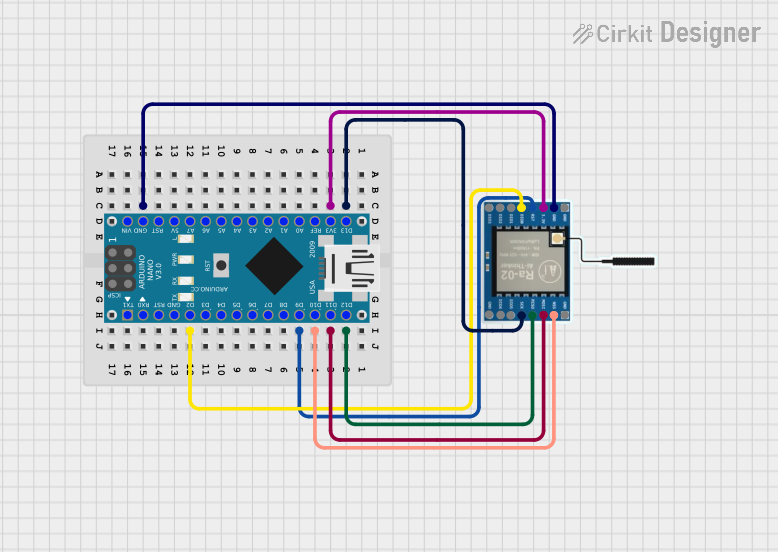
 Open Project in Cirkit Designer
Open Project in Cirkit DesignerExplore Projects Built with LoRaWAN

 Open Project in Cirkit Designer
Open Project in Cirkit Designer
 Open Project in Cirkit Designer
Open Project in Cirkit Designer
 Open Project in Cirkit Designer
Open Project in Cirkit Designer
 Open Project in Cirkit Designer
Open Project in Cirkit DesignerCommon Applications and Use Cases
- Smart agriculture (e.g., soil moisture monitoring, livestock tracking)
- Industrial IoT (e.g., predictive maintenance, asset tracking)
- Smart cities (e.g., parking sensors, waste management)
- Environmental monitoring (e.g., air quality, weather stations)
- Home automation and security systems
Technical Specifications
Below are the key technical details and pin configuration for the LoRaWAN module by Radioenge:
Key Technical Details
| Parameter | Value |
|---|---|
| Frequency Band | 868 MHz (EU) / 915 MHz (US) |
| Modulation | LoRa (Long Range) |
| Data Rate | 0.3 kbps to 50 kbps |
| Communication Range | Up to 15 km (line of sight) |
| Power Consumption | Sleep: <1 µA, Transmit: ~125 mA |
| Operating Voltage | 2.1V to 3.6V |
| Operating Temperature | -40°C to +85°C |
| Antenna Interface | 50 Ω impedance |
| Network Topology | Star |
Pin Configuration and Descriptions
| Pin Number | Pin Name | Description |
|---|---|---|
| 1 | VCC | Power supply (2.1V to 3.6V) |
| 2 | GND | Ground connection |
| 3 | TX | UART Transmit pin |
| 4 | RX | UART Receive pin |
| 5 | RESET | Reset pin (active low) |
| 6 | DIO0 | Digital I/O for interrupt or status signaling |
| 7 | DIO1 | Digital I/O for interrupt or status signaling |
| 8 | ANT | Antenna connection |
Usage Instructions
How to Use the Component in a Circuit
- Power Supply: Connect the VCC pin to a regulated power source (2.1V to 3.6V) and the GND pin to the ground.
- UART Communication: Connect the TX and RX pins to the corresponding UART pins of your microcontroller (e.g., Arduino UNO).
- Antenna: Attach a compatible antenna to the ANT pin for optimal signal transmission and reception.
- Reset: Use the RESET pin to initialize the module when required.
- Digital I/O: Use the DIO0 and DIO1 pins for interrupt handling or status monitoring.
Important Considerations and Best Practices
- Antenna Placement: Ensure the antenna is placed away from metal objects to avoid signal interference.
- Power Supply: Use a stable power source to prevent communication errors.
- Firmware Updates: Check for firmware updates from Radioenge to ensure compatibility with the latest LoRaWAN standards.
- Regulatory Compliance: Operate the module within the frequency bands allowed in your region (e.g., 868 MHz in Europe, 915 MHz in the US).
Example: Connecting LoRaWAN to Arduino UNO
Below is an example of how to connect and use the LoRaWAN module with an Arduino UNO:
Circuit Connections
| LoRaWAN Pin | Arduino UNO Pin |
|---|---|
| VCC | 3.3V |
| GND | GND |
| TX | RX (Pin 0) |
| RX | TX (Pin 1) |
| RESET | Digital Pin 7 |
Arduino Code Example
#include <SoftwareSerial.h>
// Define LoRaWAN module pins
#define LORA_RX 10 // Arduino pin connected to LoRa TX
#define LORA_TX 11 // Arduino pin connected to LoRa RX
// Create a SoftwareSerial instance for LoRa communication
SoftwareSerial loraSerial(LORA_RX, LORA_TX);
void setup() {
// Initialize serial communication with the LoRa module
Serial.begin(9600); // For debugging via Serial Monitor
loraSerial.begin(9600); // LoRa module baud rate
// Send initialization message to LoRa module
Serial.println("Initializing LoRaWAN module...");
loraSerial.println("AT"); // Send AT command to check communication
// Wait for response from LoRa module
delay(1000);
if (loraSerial.available()) {
String response = loraSerial.readString();
Serial.println("LoRaWAN Response: " + response);
} else {
Serial.println("No response from LoRaWAN module.");
}
}
void loop() {
// Example: Send a message via LoRaWAN
loraSerial.println("Hello, LoRaWAN!");
Serial.println("Message sent: Hello, LoRaWAN!");
// Wait for 5 seconds before sending the next message
delay(5000);
}
Troubleshooting and FAQs
Common Issues and Solutions
No Response from the Module
- Cause: Incorrect wiring or baud rate mismatch.
- Solution: Double-check the connections and ensure the baud rate matches the module's default setting (typically 9600 bps).
Poor Communication Range
- Cause: Improper antenna placement or environmental interference.
- Solution: Place the antenna in an open area, away from obstructions and metal objects.
High Power Consumption
- Cause: Module not entering sleep mode.
- Solution: Use appropriate AT commands to enable low-power mode when the module is idle.
Data Transmission Errors
- Cause: Signal interference or incorrect frequency settings.
- Solution: Verify the frequency band is set correctly for your region and minimize sources of interference.
FAQs
Q: Can I use the LoRaWAN module with a 5V microcontroller?
A: No, the LoRaWAN module operates at 3.3V. Use a level shifter to interface with 5V microcontrollers.
Q: What is the maximum range of the LoRaWAN module?
A: The module can achieve up to 15 km range in line-of-sight conditions. However, range may vary depending on environmental factors.
Q: How do I update the firmware of the LoRaWAN module?
A: Refer to the Radioenge documentation for firmware update procedures and tools.
Q: Can I use multiple LoRaWAN modules in the same network?
A: Yes, LoRaWAN supports a star network topology, allowing multiple devices to communicate with a central gateway.